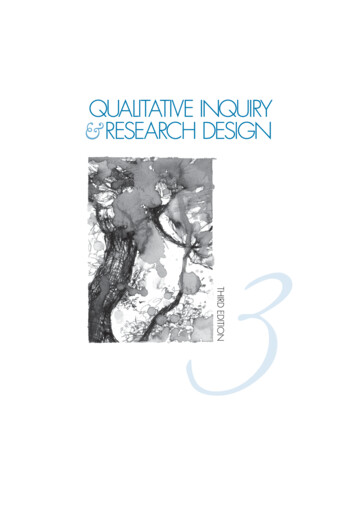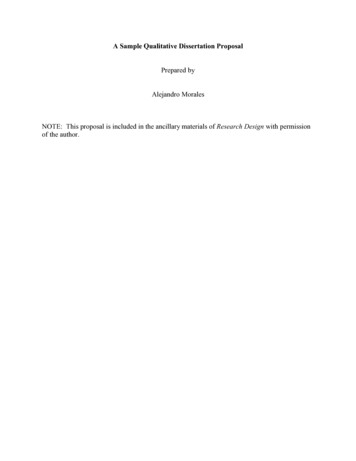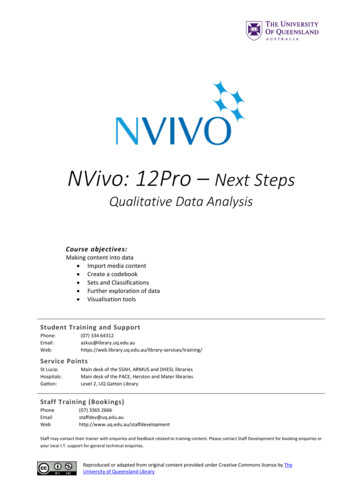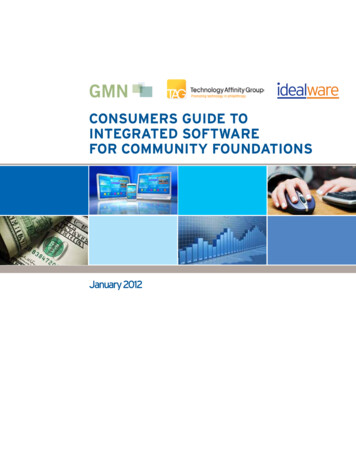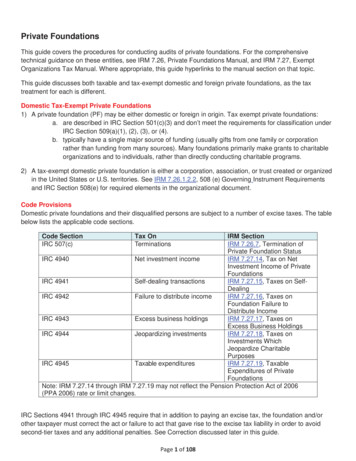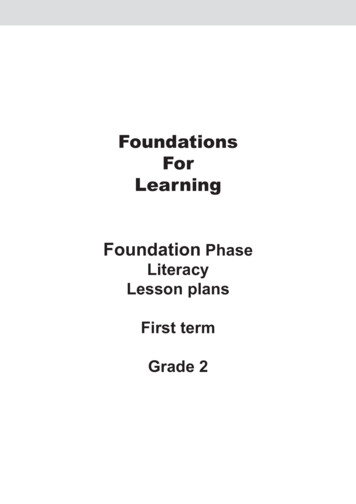
Transcription
1QCAmap Step by Step – a Software HandbookPhilipp Mayring, Klagenfurt/Austria 2020Introduction: Foundations of Qualitative Content Analysis(from Mayring, Philipp (2019) Qualitative Content Analysis: Demarcation, Varieties, Developments [30paragraphs]. Forum: Qualitative Social Research, 20(3), Art. 16, https://dx.doi.org/10.17169/fqs20.3.3343.I want to outline the most salient points in the characterization of the type of content analysisthat we have developed (MAYRING, 2015; MAYRING & FENZL, 2019). The qualitative content analysis' approach (as with the quantitative content analysis)is category-based, that is its distinguishing feature. Categories refer to aspects withinthe text, which put the meaning of those aspects in a nutshell. Text evaluation is,therefore, restricted to the selected category system. Text contents that are notaddressed by the categories or holistic impressions are not taken into account orwould have to be addressed with other text analysis methods. The qualitative content analysis procedure is research question oriented. Textanalytical questions (possibly several) are derived from the main aims of the researchproject. These questions should be answered at the end of the analysis. This clearlydistinguishes the qualitative content analysis from other completely open, explorativemethods such as grounded theory. Qualitative content analysis is characterized by strict rule management andsystematic. Process models enable the procedure to be described step-by-step, andthis has proven itself in countless research processes. The specific rules for eachtechnique are reviewed in a pilot study and should not be changed after that. I have described several specific evaluation options as part of the qualitative contentanalysis. Recently, I proposed and developed eight techniques (MAYRING, 2015):1. Summarizing2. Inductive category formation3. Narrow context analysis4. Broad context analysis5. Formal structuring6. Content structuring7. Type-building content analysis8. Scaling structuring.Besides the techniques above, there are also mixed variants. In other places(MAYRING, 2014), I have referred to structuring as an ordinal or categoricaldeductive category application. Further, I have made reference to type building andcontent structuring among others as mixed techniques. The decision for a specificcontent-analytical technique depends on the formulation of the research question. It ispossible to use individual techniques alone, but also several techniques can be usedsimultaneously during one of the iterative steps in the content analysis.
2 The content-analytical rules for the individual techniques are not arbitrary but have asolid theoretical foundation in the processes of everyday text analysis. In particular,regarding how these processes have been examined in cognitive psychology andpsycholinguistics. For summary and inductive category formation, these are reductiveoperators (omission, generalization, construction, integration, selection, and bundling;MANDL, 1981), on which the gradual reduction of text segments is based. Forexplications, it is rather context theories from linguistics. Whereas for deductivecategory applications, reference is made to the categorization theories from generalpsychology and language development research (MAYRING, 2014). The result of thiswas that the exact wording for a human-readable general category requires anexplicit definition (definition theory), a cognitive anchoring in typical examples for thecategory (prototype theory), and rules to demarcate the categories from one another(decision bound theory, MURPHY, 2002). These coding guidelines are the basis forthe three-part coding—definitions, anchor examples, and coding rules—applied in theprocedure that I recommended (MAYRING, 2015). Thus, when trying to determinecontent-analytic rules, I try to use strategies that draw on the everyday handling oftexts, a method that is common in qualitative research, for example, when linguisticapproaches to storytelling in everyday life are employed in the rules for narrativeinterviews.Software tools for qualitative text analysisWithin the last 30 years many approaches of computer assisted qualitative text analysis hadbeen developed (see e.g., KUCKARTZ, GUNENBERG & DRESING, 2007; SILVER &LEWINS, 22014). None of those programs is specially adapted for Qualitative ContentAnalysis. This was because the separate processing steps involved in qualitative contentanalysis are difficult to implement in conventional and commercial programs. For example, itis not easy to keep the central content-analytical rules (category definitions, levels ofabstraction, coding guidelines) constantly visible alongside the analysis. This only works to alimited extent using the memo function in MAXQDA, and that actually belongs to thegrounded theory methodology. A table notation, central for summary and coding guidelines,can only be achieved partially. For these reasons, we have developed our own softwareprogram QCAmap (FENZL & MAYRING, 2017; MAYRING, 2014), which offers the followingadvantages: free use; interactively guiding users through the steps of content analysis; templates for the individual techniques such as summary, inductive categorydevelopment, and deductive category application templates for the individual analysis units that should be defined as well as contentanalysis rules; ongoing maintenance and further development of the program as a web application; interactive possibilities for raters, also for intercoder comparisons; a manual (MAYRING, 2014) that can be downloaded free of charge.The interactive nature of the program ensures that the essential steps of the qualitativecontent analysis are actually carried out. The program has been used in more than twenty
3thousand projects since 2013. A new version with brand new features is planned for 2020. Infuture versions, we plan to integrate video analysis into the program.Precisely because of its intermediate position between qualitative and quantitative analysis,qualitative content analysis appears to be an important methodical starting point. On the onehand, it is used for including measurements and numerical data from standardizedinterviews, questionnaires, observation systems, or test instruments in research projects. Onthe other hand, it also takes into account data from open surveys and observations in such away that the resulting texts are analyzed as systematically as possible in an analysis that isguided by the research question as well as being both theory-based and rule-based in itsapproach.For the references and for further remarks to the logic of qualitative Content Analysis, as wella discussion of the differences to other concepts of content analysis see the whole article, inEnglish and in German, free access cle/view/3343
4QCAmap2020 – Step by StepWhen searching for QCAmap you will immediately come across the linkhttps://www.qcamap.org and its associated homepage:The first blue button (Intro & Info) will take you to our homepage for QualitativeContent Analysis (www.qualitative-content-analysis.org). There, we strive to informyou (in English and German) about the following: Latest news,The Association for Supporting Qualitative Research ASQ ofit-asq/), a non-profit organisation located inKlagenfurt (Austria) behind the know-how and development of QCAmap,Our software QCAmap, including the new features in the latest versionQCAmap2020 are-2/qcamap-
5 2020-2/) and a series of slides t/uploads/QCAmap2020Intro.pdf),Publications of our team on Qualitative Content Analysis,Possibilities to support our (free open access) work (sponsorship),The team (Philipp Mayring, Thomas Fenzl, Stella Lemke)Workshops on QCAmap (the annual Austrian summer workshop and externalworkshops organized by the team).The blue news button leads you to the first bullet point in the list above.“How to get started” provides a quick introduction about how to start the program.The green button (“Login & start working”) takes you to the free open access programQCAmap.To create an account, the first step is to fill in a valid email address and a password.You will receive an email (please check your spam folder as well) that contains a linkfor you to confirm your email address. Once that is done, you have access (email andpassword) from anywhere that has the necessary hardware, browser, and internetconnection.This is the first screen:You can define a project (“Create new project”) on this screen. A project is a series ofdocuments (texts, pictures) and a main research question that maybe has severalsub-questions for analysis. Perhaps you have been invited for an intercoderagreement test from another QCAmap user; this would be displayed in “CoderAgreements”. The green band, is shown on every page in the program, it gives youthe possibility to check your profile, to read the data protection statement and to sendan email to the support hotline (“Help”). Please do not forget to logout when you havefinished your work.Creating a projectIf you create a new project, a new screen will appear in which you can type a title forthe project and then a description. You can change those settings afterwards. Oncethe projected is created, the following screen is shown:
6The title (Testproject) and description (This is an example project definition) alwaysappear when you open this project. The first line contains three symbols, and the firstsymbol allows you to share the project with other persons (they must have aQCAmap login, and then you can assign them editing or read-only rights ). Projectinformation can be edited (the pen symbol) and the project can be deleted (red binsymbol).A question for analysis has not been defined yet; however, we can do it afterwards. Ifyou do it straightaway the system would inform you that you have to uploaddocuments before coding. Before uploading documents, please make sure that youhave anonymised the data. That means inserting black stipes over people’s eyes inpictures; or using abbreviations for personal information (e.g., names, places) in text.The format of text files is indicated by the file extension, for example, as txt or docxfiles, or JPG, GIF, and PNG files for pictures. Press “Add files”, select the files, andpress “Upload new Documents”.Below you can see that we have uploaded two texts and one picture:
7Doing text analysis by Qualitative Content Analysis, the definition of a researchquestion is fundamental. We do not carry out with a free impressionistic interpretationof the material (which could be appropriate in explorative projects). Instead we willanswer research questions connected to the theoretical background of the project.The elaborated formulation of the research question (as a sentence with aninterrogation mark at the end!) is crucial because it leads you to the most appropriatecontent analytical technique: What characterizes the field? What is important in ?Technique of summarizingWhat forms of can be found? What do they say about ?Inductive category formationCan I find in the material?Deductive category applicationWe can formulate a general research question and several sub-questions about thesame material. In the program, those questions are denominated “Question foranalysis”. After starting it, you have to decide on the most suitable technique. A pulldown menu gives you the three possibilities that have been implemented so far.Inductive category developmentRoughly speaking a large part of all questions for analysis within Qualitative ContentAnalysis are inductive category formations.
8Those choices and inputs have to be saved manually. Afterwards (in coding mode),all actions are saved automatically. Of course, you can change it at the question foranalysis level.If you select one of the three techniques, the corresponding procedure and rules aredisplayed: for summarizing, the levels of paraphrasing, generalization, and reduction,for inductive category formation, the category definition and level of abstraction, andfor deductive category application the categories and coding guideline. In ourexample, we have formulated the following question for analysis: “Which stressfactors are mentioned in the texts?”, which clearly needs an inductive categoryformation.
9In all techniques, the content analytical units (explained on the screen) have to bespecified. Furthermore, a step model and corresponding rules can be displayed (therespective link is written in blue) for all techniques. Click the link, and it will openaseparate screen.Three content analytical rules have to be defined (if you forget this, the system warnsyou and does not allow coding). In inductive category formation the recording unit isfixed as “all documents”. Recording unit means the amount of material that is to beconfronted using the category system. New categories can be added from documentto document during inductive category formation. The whole list of categoriesrepresents all documents at the end of coding, thus this has to be the recording unit(you cannot change it).A decision has to be made with respect to counting multiple codings. At the end, a listof all categories is presented (as an Excel file) with the frequencies of occurrences ofcategories. If a category was coded several times within one document, it could makesense to count this, especially when the abstraction level is high: A person describesproblems to pay the rent and difficulties to afford a holiday trip as stress factors. Both
10of them are coded as financial stress and therefore should be counted twice. If,however, you decided for a very concrete level of abstraction, and the same personrepeatedly talks about his problems to pay his rent, this should be counted only onetime. In our example, the “Count multiple codings” checkbox is not selected.Please don’t forget to save your inputs and choices, once that is done, you canswitch to the coding mode:All definitions and selections are displayed on the left side to guide you through thecoding process. A search function displays all text passages that were coded with acategory. You can look at all categories developed up to this point on the right-handside of the page or hide this. If you have worked through all documents, you canfinish coding and enter the analysis tool. Nevertheless, you can reopen coding at anypoint if necessary.Marking a text passage (in the example below, line two and three) opens a windowcontaining all categories formulated up to now. You can subsume the text passage toone of those categories or formulate a new category (the last line in the categorywindow). All categories are indexed with the number of the research question (RQ)and a continuous number.
11If you have finished coding you are presented with the following screen:If you press “Stop categorization”, then the “Analysis” is activated. It’s possible to goback and do further categorizations (“Continue categorization”) in the material, andas you would expect different output files would be created, if any categorizationswere changed. You can also check for coder agreements (I will describe this later).The “Analysis” button takes you to the following screen:
12First, you can formulate main categories, integrating the inductive categories togroups. This is a process of inductive (looking for similarities between the categories)or deductive theory bound argumentation. If you have defined main categories, theoutput files will contain frequencies for them as well.Further analysis is done by creating three output files in Excel-format: “Download coded passages” creates a list of all categories and theircorresponding text passages.“Download category statistics” creates a table of categories and theirfrequencies, including percentages of all categories and percentages ofdocuments, in which the categories occurred:
13Naturally, within Excel you can edit the table. The category ID indicates the numberof the research question (RQ2 in this case) and the category number associated withthat question. “Download document statistics” creates an Excel-file, which can be furtheranalysed with statistical procedures. It is a table of categories andoccurrences; it contains four documents and eight inductive categories in oursimple example:Deductive Category AssignmentYou should choose deductive category assignment, if the theoretical background ofthe research question enables you to formulate categories before working with yourtexts. In addition, if you are interested in the occurrence and/or frequency of thosecategories within the texts. The program will guide you through different steps ofanalysis.There are two forms of deductive category assignments: a nominal list of deductivecategories or an ordinal category system. We will examine an example with anordinal category system, and the following the research question: Has "practiceshock" affected the self-confidence of the individual? (categories high self-confidence– middle self-confidence – low self-confidence).As before ,the blue link (picture next page) would take you to information about thespecific step model and the rules for analysis in a separate window.You have to define the content analytical units. They might be different from the onesgiven above for the inductive question for analysis.In deductive category assignment the recording unit is predefined as “document”because every document is coded separately with the common deductive categories.Usually, every document is coded by one of the categories. For working with ordinalcategories, this is essential. I want to know if the document (the interview partner)shows high, middle, or low self-confidence. I would not “Allow multiplecategorizations” because at the end of the analysis I want to know how many
14persons (documents) show high, middle, or low self-confidence (for this reason therespective checkbox is not selected at the bottom of the picture below).If the documents (e.g., interviews) are very extensive, covering different areas, itmight be interesting when a given category occurs several times in one document. Inthat case, you should click “Count multiple codings”. Again, for ordinal categorysystems it is not recommended because it is an act of interpretation, taking allrelevant phrases together, to decide for one of the ordinal categories, and typicallynot a case for counting. For the same reasons, we do not recommend coding all textpassages relevant to the ordinal variable on one of the categories, and then countingwhich category occurs most often within one document.The next step would be to write a coding guideline (click on “Coding guideline – addnew category”). This is the central instrument in deductive category assignment.Please formulate an explicit definition for each deductive category based on thetheoretical background of the project. Within the pilot phase you may find a goodexample for one of the categories. If so, you can put it in coding guideline as “anchorexample”. If you come to a text passage for which you are not sure about the rightcategory, then it would be necessary to decide based on the theoretical background,formulating an additional coding rule for further codings. In doing so, the coding
15guideline will be adapted as you go along, as displayed in the example. Please donot forget to save changes in the coding guideline. After the pilot phase, the codingguideline cannot be changed any longer; it is crucial that you code all material withthe same coding guideline.Now you can code the material:
16When marking the material, you can, of course, only assign one of the preformulatedcategories.Having coded all documents, please press “Finish coding” (left-hand side at thebottom) and go to “Analysis”. QCAmap creates three Excel-files for you as results:the coded passages together with the code, the coding guideline, and most importantfor deductive category assignment, a table with documents and categories:This table can be further analysed using statistical procedures.SummarizingSummarizing is a content analytical technique used for Smaller amounts of material because it is very extensive,Diffuse material, in which it’s difficult to ascertain the central points,Explorative research questions, where categories cannot be formulated inadvance.Summarizing content analytical procedures convert the whole text into singlepropositions and generalizes those propositions step by step to its core categories.
17The result is a table with all those steps, almost as extensive as the original text.Inductive category formation is based on this procedure, but much more economical: There is no paraphrasing.Only text passages relevant to the research question were taken intoconsideration.The categories are directly formulated on a predefined level of abstraction andnot generalized step by step.Hence, think carefully about whether inductive category formation might be moreappropriate before deciding for summarizing.The procedure starts with the formulation of propositions. Every sentence has to bereduced to its content.“Finish paraphrasing” at the left bottom gives you the possibility to work with thoseparaphrases. Immediately you are asked to define the level of abstraction for thisstep. Afterwards you can generalize the paraphrases or leave them out if they areduplicated or included in other generalized paraphrases.
18The next step would be to summarize further. Press “Stop generalization”.Every paraphrase has to be generalized or left out. At the end, the “Finishgeneralization” button takes you to the next step. It gives you the possibility to reducethe generalized paraphrases.
19“Finish 1st reduction” leads either to the next round of generalizations and reductionsor it stops the summarizing process. If we would stop here, we would have developedtwo summarizing categories from one page of the transcript. The two categories areon a different level, which is typical for summarizing because we did not have acategory definition. The summary addresses all material, and this only makes sensefor very explorative research questions. The output files contain the paraphrases, orthe whole process of generalization and reduction.Coder AgreementsQCAmap offers the possibility to rate the intra-coder agreement as a measure forreliability and the inter-coder agreement as a measurement for objectivity as centralquality criteria in qualitative content analysis.On the project page, for every question for analysis the two checks can be opened.For inter-coder agreement tests, please fill in the email address of the second coder(who has to be registered within QCAmap). In both cases, a pull-down menu offersthree possibilities within inductive category formation.
20 The strongest test would be to give myself (intra-coder) or the other person(inter-coder) only the documents and research questions. She or he has toformulate the categories and assign them to the material.A medium test consists in a remake of the codings. The main category systemis given to the second coder.The weakest test shares all categories and codings with the second coder.This is a form of supervision.For deductive categories, only the second test makes sense. The second coder isgiven the (preformulated) categories and tries to assign them to the texts. Forsummarizing, no agreement checks are offered.In this example, the intra-coder agreement with shared categories was finished, andby pressing the Compare link, I can see the test results – with original codes on theright side and second codes on the left side (thus in the excerpt below there is noagreement for the two categories shown):
21Only for deductive category assignment does a statistical inter-rater agreementcalculation (e.g., Cohens Kappa) makes sense. In inductive category formation thedegree of agreement has to be rated by the first project author. By choosing thebutton “set acceptance”, she or he can assign an agreement of bad, moderate, goodor excellent.That’s it; enjoy the program!
Precisely because of its intermediate position between qualitative and quantitative analysis, qualitative content analysis appears to be an important methodical starting point. On the one hand, it is used for including measureme


